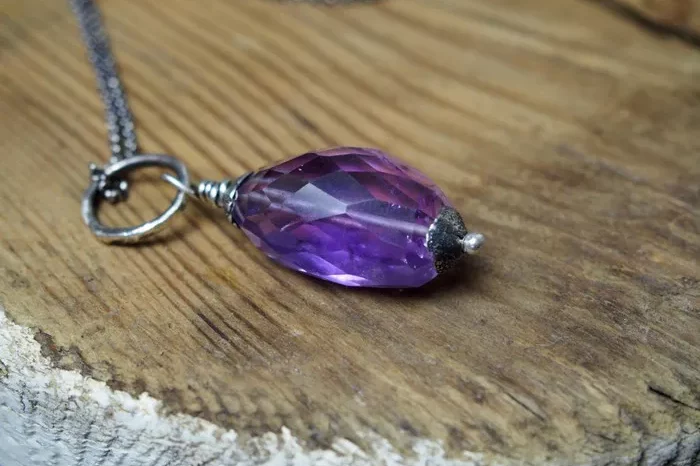Amethyst crystals are a type of quartz that exhibits a striking purple hue, making them highly sought-after in the world of gemstones and jewelry. This unique coloration is a result of natural iron impurities within the crystal structure, which, under specific geological conditions, interact with light to produce the mesmerizing purple shades. Amethyst has held a place of reverence and fascination in human culture for millennia, with its name derived from the Greek word “amethystos,” meaning “not drunken,” reflecting ancient beliefs in its ability to prevent intoxication.
Formation and Growth
The formation of amethyst crystals begins deep within the Earth’s crust, where geological processes create the ideal conditions for quartz crystallization. High temperatures and pressures, combined with the presence of minerals such as iron, are crucial for the development of amethyst’s distinctive color. Research indicates that amethyst crystals can be grown synthetically using methods like the hydrothermal process. This involves using a reaction medium, such as a KOH and NH4F aqueous solution, with dissolvable iron-salt as a dopant, under carefully controlled conditions to produce uniformly colored crystals.
Natural amethyst crystals often form in clusters, with individual crystals growing in a variety of shapes and sizes. These clusters can be found in igneous rocks, such as lavas and pegmatites, and metamorphic rocks like gneiss and schist. The process of extracting and polishing these crystals into gemstone-quality pieces requires skilled craftsmanship and a deep understanding of gemstone properties.
Physical and Chemical Properties
Amethyst crystals belong to the trigonal crystal system, with a hardness of 7 on the Mohs scale, making them relatively durable for everyday wear. Their hardness and clarity contribute to their appeal in jewelry making, allowing for intricate designs and settings. The purple coloration can range from a light lavender to a deep, almost royal purple, with some crystals displaying zoning—bands of differing color intensity—within their structure.
Chemically, amethyst is composed primarily of silicon dioxide (SiO2), with trace amounts of iron oxide (Fe2O3) responsible for its color. This composition makes amethyst a relatively stable gemstone, resistant to most chemicals and environmental factors, although it can be scratched or damaged by harder materials.
Metaphysical and Healing Properties
Beyond their physical attributes, amethyst crystals have been revered for their metaphysical and healing properties for centuries. In various cultures and traditions, amethyst is believed to promote spiritual growth, enhance intuition, and provide protection against negative energy. Its calming purple hues are associated with relaxation, stability, and peace.
Spiritual Growth and Intuition
Amethyst is often recommended for those seeking to deepen their spiritual practice or meditation. Its energy is thought to facilitate connection with the higher self, aiding in self-discovery and spiritual awakening. Many practitioners believe that wearing or meditating with amethyst crystals can enhance intuition, clarity of thought, and overall spiritual awareness.
Stress Reduction and Calming
The calming influence of amethyst is particularly beneficial for those struggling with stress, anxiety, or insomnia. By placing an amethyst crystal in one’s bedroom or wearing it as jewelry, it is believed to promote restful sleep and reduce feelings of tension and worry. Its soothing energy is also thought to balance the crown chakra, the energy center associated with spiritual connection and higher consciousness.
Protection and Purification
Amethyst is also known for its protective properties, believed to shield the wearer from negative energy and influences. In ancient times, it was worn as a talisman to protect against danger and evil spirits. Today, amethyst crystals are often used in healing practices to purify the aura and create a protective barrier around the individual.
Birthstone Significance
Amethyst is the traditional birthstone for February, making it a popular choice for those celebrating their birthday during this month. As a birthstone, amethyst symbolizes wisdom, serenity, and spiritual awareness. It is believed to bring balance, harmony, and inner peace to its wearer, making it an excellent gift for someone seeking to cultivate these qualities in their life.
Jewelry Applications
Due to its beauty and durability, amethyst is a popular choice for jewelry design. Its purple hue complements a wide range of fashion styles, from classic and elegant to modern and bold. Amethyst can be found in various jewelry forms, including rings, necklaces, earrings, and bracelets, allowing individuals to express their personal style and taste.
When selecting amethyst jewelry, it is important to consider the quality of the gemstone. Factors such as color saturation, clarity, cut, and carat weight all contribute to the overall value and appearance of the piece. High-quality amethyst crystals will exhibit a rich, even color with minimal inclusions or flaws.
Care and Maintenance
To maintain the beauty and durability of amethyst jewelry, it is important to follow proper care and maintenance practices. Amethyst, like all gemstones, should be stored in a soft cloth or jewelry box to prevent scratching or damage. When cleaning, use a mild soap and warm water solution, avoiding harsh chemicals or abrasive cleaners that could dull the surface or damage the gemstone.
Additionally, amethyst is sensitive to heat and sudden temperature changes, which can cause cracks or fractures in the crystal structure. Therefore, it is important to remove amethyst jewelry before engaging in activities that may expose it to extreme temperatures, such as cooking or showering.
Conclusion
Amethyst crystals are a beautiful and versatile gemstone with a rich history and a variety of uses. Their unique purple hue, combined with their durability and metaphysical properties, make them a popular choice for jewelry and healing practices. By understanding the formation, properties, and care of amethyst crystals, individuals can appreciate their beauty and make informed decisions when selecting and maintaining this stunning gemstone. Whether worn as a symbol of personal power or used in meditation and healing practices, amethyst crystals offer a connection to the natural world and a touch of magic in everyday life.
Related topic:
- Best Crystals to Pair with Amethyst
- What Are the Disadvantages of Wearing Amethyst
- Can I Wear Amethyst to Bed


